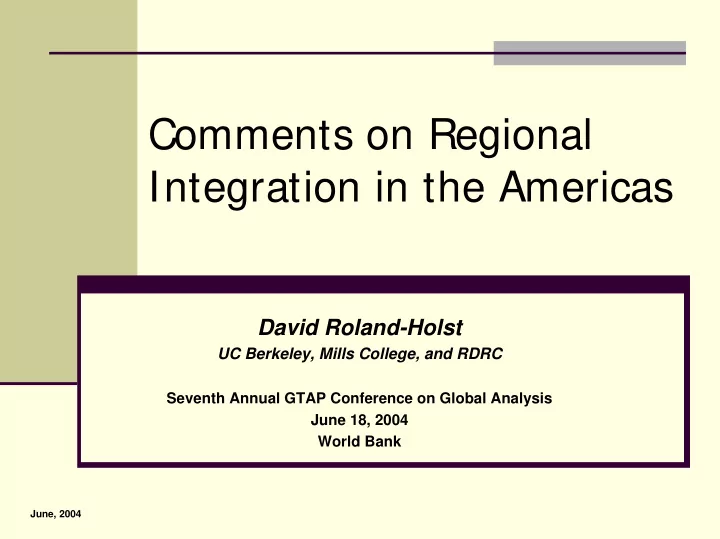

Comments on Regional Integration in the Americas David Roland-Holst UC Berkeley, Mills College, and RDRC Seventh Annual GTAP Conference on Global Analysis June 18, 2004 World Bank June, 2004
Contents � Lessons from Experience (if not from theory) � Looking Ahead Roland-Holst June, 2004 2
Regionalism vs. Globalism? A moot point Regional agreements have grown exponentially Cumulative numbers of FTAs, 1958-2003 200 180 160 140 120 100 80 60 40 20 0 1958 1961 1964 1967 1970 1973 1976 1979 1982 1985 1988 1991 1994 1997 2000 2003 Roland-Holst June, 2004 3
Rules of thumb for Regionalism � The more inclusive, the better � The more diverse, the better � Stay on the path to globalism � Capital account – gradualism � Exchange rates – no consensus Roland-Holst June, 2004 4
Looking Ahead Four emergent areas that deserve more emprical attention: 1. Where does LAC fit into the global activity matrix? 2. Regime change: From export competition to import competition 3. Making trade-based growth sustainable: climbing the value-added ladder Roland-Holst June, 2004 5
Looking Ahead: Where does LAC fit in? � Our forecasts indicate the emergence of a systematic pattern of triangular trade between China, the Rest of East and Southeast Asia, and the Rest of the World � This Trade Triangle reveals that China’s growth offers significant growth leverage to many trading partners. � Chinese absorption is already the primary driver of regional growth. How far will this extend? Roland-Holst June, 2004 6
Trade Triangle 2000 Roland-Holst June, 2004 7
Trade Triangle 2020 LAC? Roland-Holst June, 2004 8
FTAs involving East Asian and Latin American Countries Signed or ratified Under negotiation AFTA (1992) China-ASEAN Singapore-New Zealand (2001) Japan-ASEAN Japan-Singapore (2002) Korea-ASEAN U.S.-Singapore (2003) Japan-Korea Korea-Chile (2004) Japan-Chile Japan-Mexico (2004) Korea-Mexico Korea-Singapore Singapore-Mexico Singapore-Chile, etc. Roland-Holst June, 2004 9
Looking Ahead 2: From export competition to competition for imports A tectonic regime shift in Global Trade China’s export position is now well established, but the pace of absorption is forcing it onto more intense competition for resources and other intermediate goods. � Resource seeking integration/partnerships � Upstream FDI � Value added shifting/transfer pricing Roland-Holst June, 2004 10
Looking Ahead 3: Making trade- based growth sustainable � Export success for LAC has been a mixed blessing in the past � Follow Asia’s example and make the transition from resource booms to human- capital based development Roland-Holst June, 2004 11
Recommend
More recommend